|
|
ADDRESS AT THE INAUGURATION OF THE NATIONAL WORKSHOP ON 'VISION 2020 - INDIA' (PURA AND GROWTH CENTRES FOR MAKING INDIA A DEVELOPED NATION), NEW DELHI
12-11-2005 : New Delhi
Development Ambience: PURA as an instrument
I am delighted to participate in the inauguration of the National Workshop on "Vision 2020 - India" (PURA as Growth Centers for Making India a Developed Nation). My greetings to the Voluntary Health, Education and Rural Development Society (VHERDS), Housing and Urban Development Corporation, New Delhi and Indian Institute of Technology (Delhi) for taking the initiative in organizing this workshop. I also greet the planners, administrators, scientists, industrial organizations, social organizations, academicians and other participants.
Presently, the annual GDP growth rate of the nation is around 7% to 8%. There is a need to increase the growth rate of the GDP by additional 2% a year for transforming India into a developed nation and making the number of people below the poverty line to be near zero, we need to progressively implement the PURA programme in different parts of the country. As you are aware, the number of PURAs required to be brought out in the whole nation is around 7,000. During this workshop many of you will be talking about the PURA. However, I would like to discuss about the enabling environment provided by the Government, some of the PURA models available in different parts of the country and the PURA components, which will enable large-scale provision of employment in the rural sector. I would like to talk to you on the topic "Development Ambience: PURA as an instrument".

Enabling Environment
Bharat Nirman Programme:The Union Government has evolved the Bharat Nirman as a four-year business plan for building infrastructure, especially in rural India. It will have six components, namely, irrigation, roads; water supply, housing, rural electrification and rural telecom connectivity. The broad goals of Bharat Nirman would be:
- bringing an additional 10 million ha of land under assured irrigation
- providing road-connectivity to all villages having a population of 1000 (or 500 in hilly/tribal areas)
- constructing 60 lakh additional houses for the poor
- providing drinking water to the remaining 74,000 habitations that are uncovered
- reaching electricity to the remaining 1,25,000 villages and electricity connections to 23 million households
- Providing telephone connectivity to the remaining 67,000 villages.
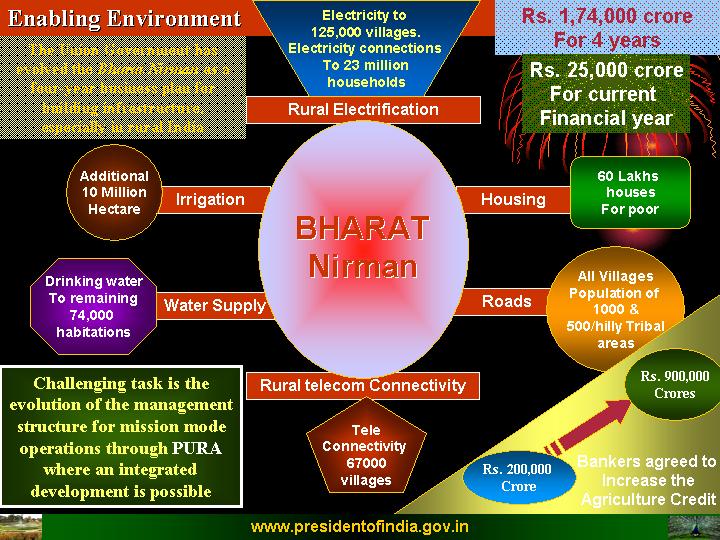
The programme, has been estimated to cost Rs. 1740 billion (Rs. 1,74,000 crore) and is to be completed in the next four years. The government has allocated an additional Rs. 250 billion (Rs 25,000 crore) for social sector programmes during the current financial year. Bharat Nirman will involve Panchayati Raj Institutions in its planning and implementation. The challenging task here is the evolution of the management structure for a mission mode operation through PURA where an integrated development is possible.
Enhancing the rural credit: Bankers have agreed to increase the agriculture and agro processing credit to Rs. 2000 billion (Rs. 200,000 crore) from the existing Rs. 900 billion (Rs. Ninety thousand crore) within the next three years in phases. This will include advances for setting up of PURA complexes and small enterprises in PURA clusters.
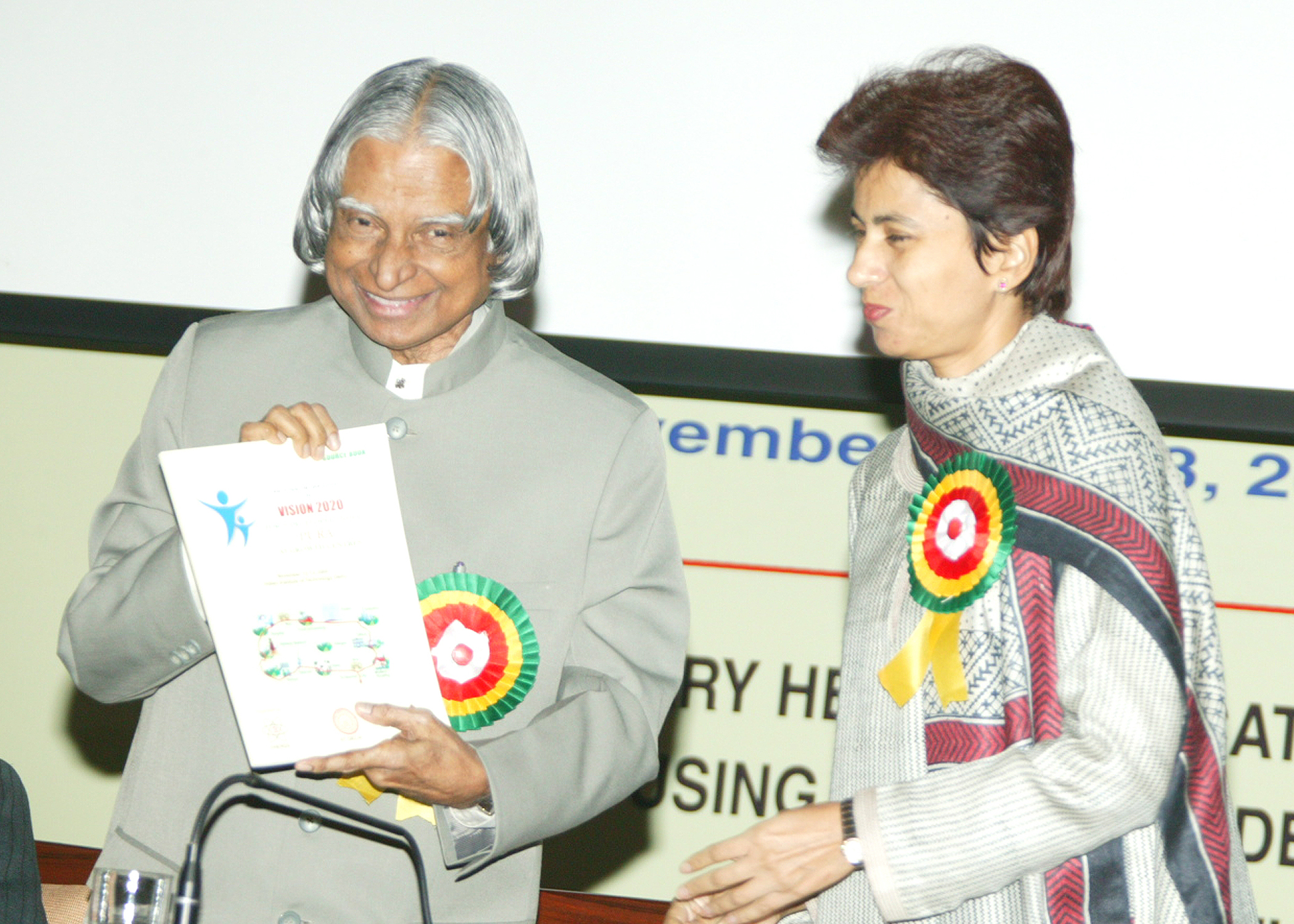
National Employment Guarantee Bill: Also, to take care of those who are likely to be left behind by development processes and to ensure that there is a safety net, especially in some of the more backward regions of the country, Central Government has come forward with a National Employment Guarantee Bill. This bill provides legal guarantee for at least 100 days of employment to at least one person in every poor household initially in some of the most backward districts of the country. This programme is to be gradually expanded to cover all rural areas. I have suggested that there should be a direct linkage of the infrastructure tasks required for the PURA with the Guaranteed Rural Employment Scheme.
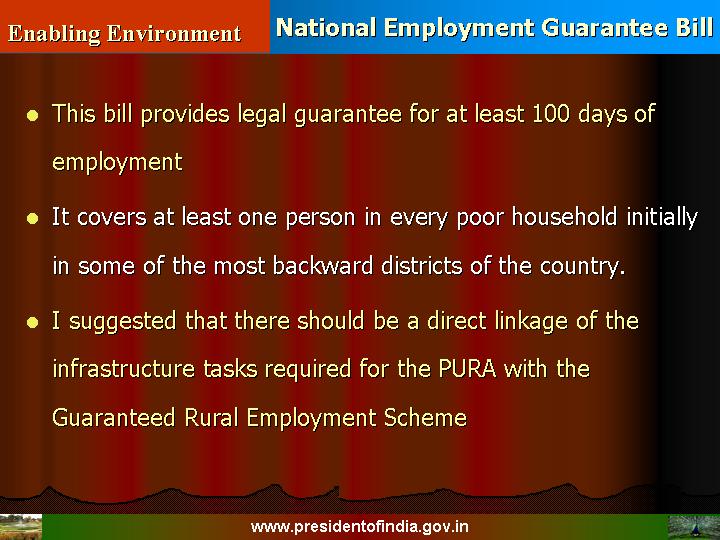
Infrastructure Development: The Government has decided to grant greater autonomy to the National Highways Authority of India while taking steps to make it more professional and efficient. The rate of completion of road construction under the national highways programme, especially the Golden Quadrilateral and the North-South and East-West corridors, has been speeded up. The Government will encourage public-private partnership in all infrastructure projects. Special focus will be given to improving rail and road connectivity in the North-Eastern region.
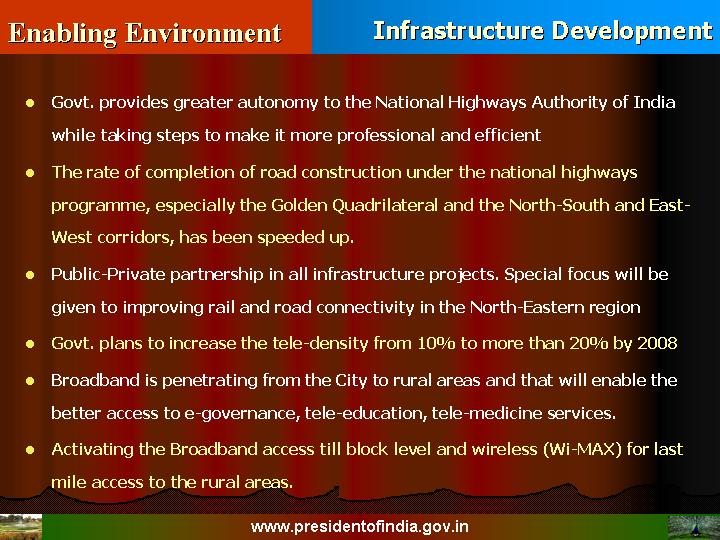
Government has plans to increase India's tele-density from the present 10% to more than 20% by 2008. The priority will be to provide both voice and data transmission connectivity in rural areas. The broadband policy announced recently would enhance Internet connectivity with increased speed. This, in turn, would help our rural areas to take advantage of the benefits of e-governance, e-education and e-health.
Biogas plants: Recently two members from TCS gave a presentation on the potential of Bio Gas plants in our rural sector. They had conducted a survey in Andhra Pradesh and Tamil Nadu to determine the current levels of feed stock and energy needs. The survey indicates: adequate feed stock biomass is available for biogas plants and adequate plant biomass is available for gasification plants for electricity generation. Most of these resources are presently being wasted are sub-optimally utilized. Activities like collection of feed materials, operation of plants, maintenance and distribution of biogas and electrical energy and other manual activities will result in local employment making these villages employment and service hubs. In addition biogas plants will also provide organic manure for farmers.
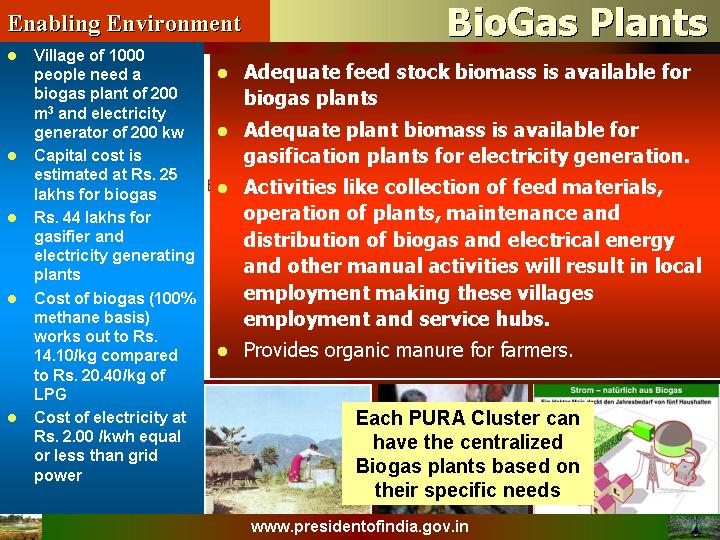
Preliminary estimates indicates that for a village with a population of thousand people will require a biogas plant of 200 meter cube and an electricity generator of 200 KWs. The capital cost is estimated at Rs. 25 lakhs for biogas and Rs. 44 lakhs for gasifier and electricity generating plants. With this capital cost the cost of biogas works out to Rs.14 per kg compare to the current price of Rs. 20 per kg of LPG and electricity at Rs. 2 per Kwh, which is less than the grid power cost. Each PURA Cluster can have the Biogas plants based on their specific needs.
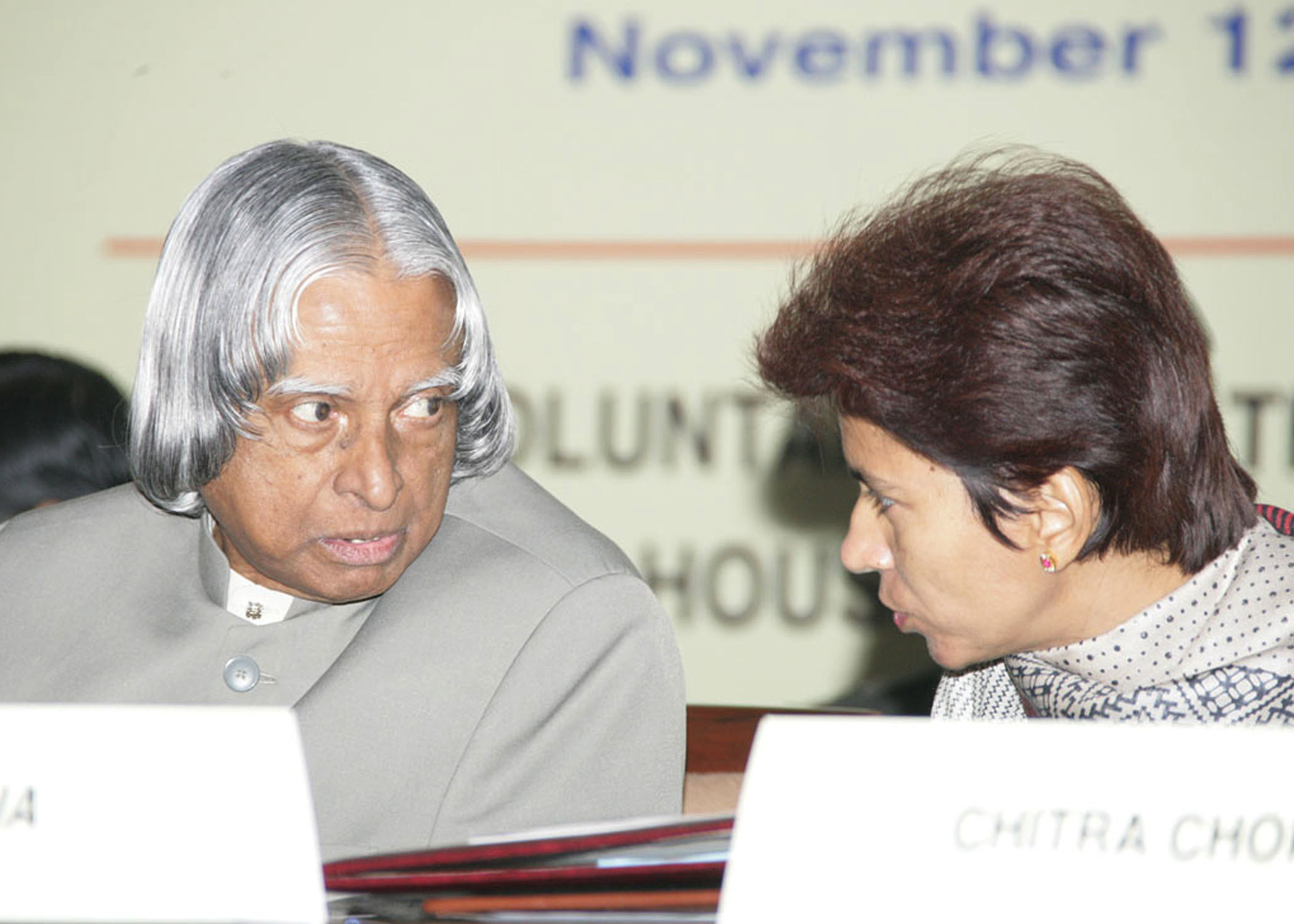
Integrated Zero Waste Management: Recently, I came across a total sanitation programme organized at Gandhi Nagar town Panchayat in Vellore district. Here the Panchayat authority in collaboration with non-government organization has been able to segregate the waste into organic and inorganic items. They have created men self help groups and women self help groups for managing the waste in the Panchayat. These groups have established roadside dustbins, which are being cleared regularly. They also have special services for hotels and marriage halls. The drainage system in the village is being cleared thrice in a week. The fault reporting system is so efficient that sanitation faults in the village are attended to and rectified within the same day. A village having two thousand four hundred families generates garbage of over 48 tones per year. This garbage is converted into manure and recyclable waste generating over Rupees three lakhs in revenue. All the two thousand four hundred families in the village are able to have a clean green village just by paying around ten rupees per month per family. The scheme provides employment to around thirty-six members who are paid employees of the Panchayat. Part of the funds required for the payment of these employees is generated by the sale of manure and recyclable waste. This appears to be a self-generating system and is economical. Many of the PURA complexes in the country may like to follow such examples for economic benefits and keeping the rural setting clean, tidy and disease free.
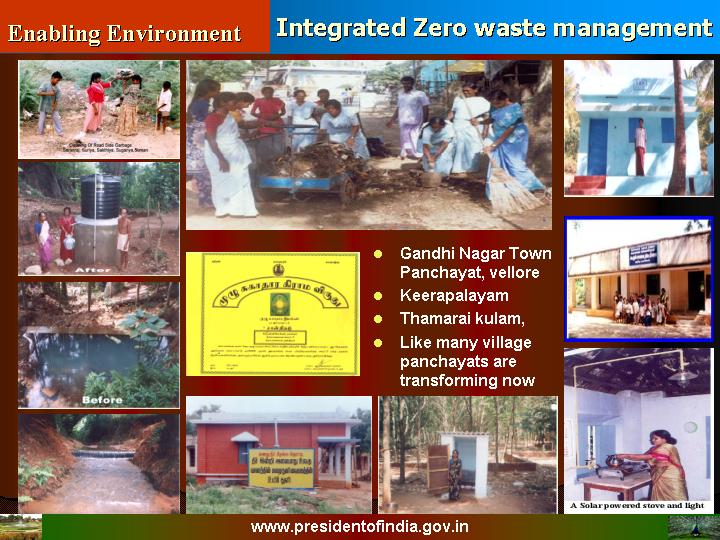
Keerapalayam Experience: In August 2004, I had visited Keerapalayam Panchayat in Cuddalore district, Tamil Nadu. When I was discussing with the Panchayat Board office-bearers, I found that every one of the thousand one hundred and twenty five dwelling units in the Panchayats had sanitary facilities. Also it was interesting to find that the women in the village had acquired masonary and plumbing skills and they had been responsible for constructing the household toilets. They not only constructed toilets for the houses in their Panchayats but also went to neighbouring villages and provided this facility on an entrepreneurial basis. This method has provided employment opportunities to the women and also enabled the Panchayat area clean, tidy and free from diseases arising out of poor sanitary conditions. Similarly effort has been reported from Tamarai Kulam Panchayat, Ramanathapuram District.
Now I would like to discuss some of the operational PURAs functioning in Tamilnadu, Maharastra and Madhya Pradesh. They are efficiently run by the private, social organizations and institutions.
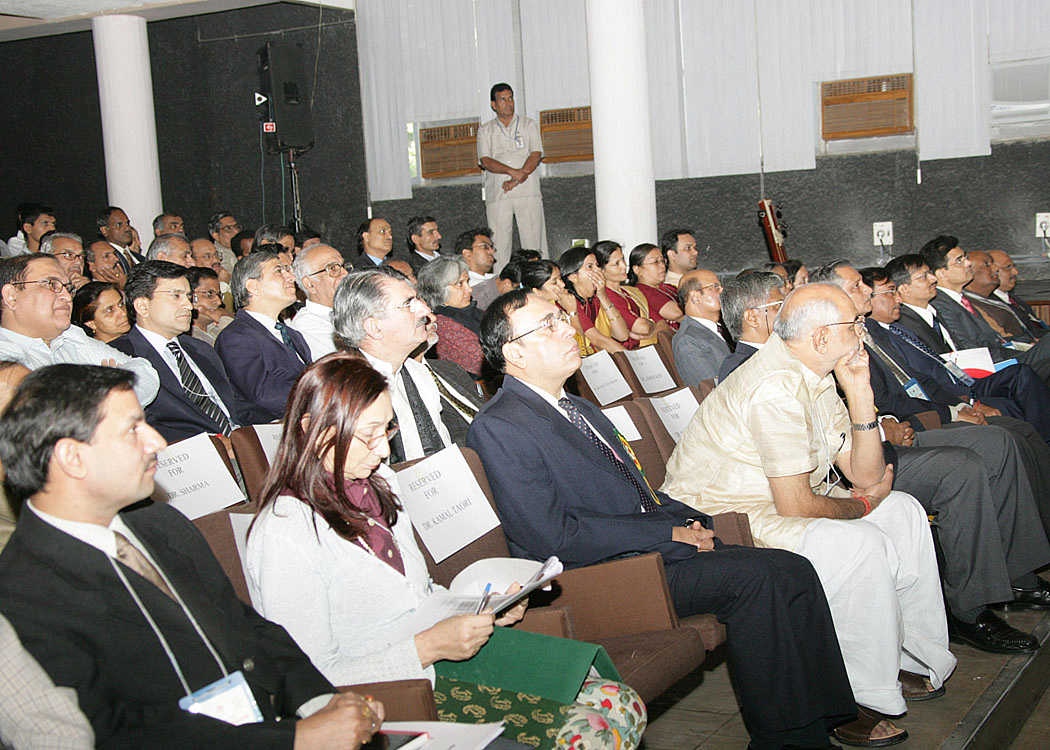

Model PURAs, which are in Operation
Periyar PURA: I had visited Periyar Maniammai College of Technology for Women and inaugurated a PURA Complex a year back. I thought of sharing with you the developmental concept of a cluster of over 60 villages near Vallam, Thanjavur district of Tamilnadu that involves a population of 3 lakhs. This PURA complex has all the three Connectivities - physical, electronic and knowledge - leading to economic connectivity. The center of activity emanates from the women engineering college that provides the electronic and knowledge connectivity. Periyar PURA has health care centers, primary to post graduate level education and vocational training centers. This has resulted in large-scale employment generation and creation of number of entrepreneurs with the active support of 850 self-help groups.
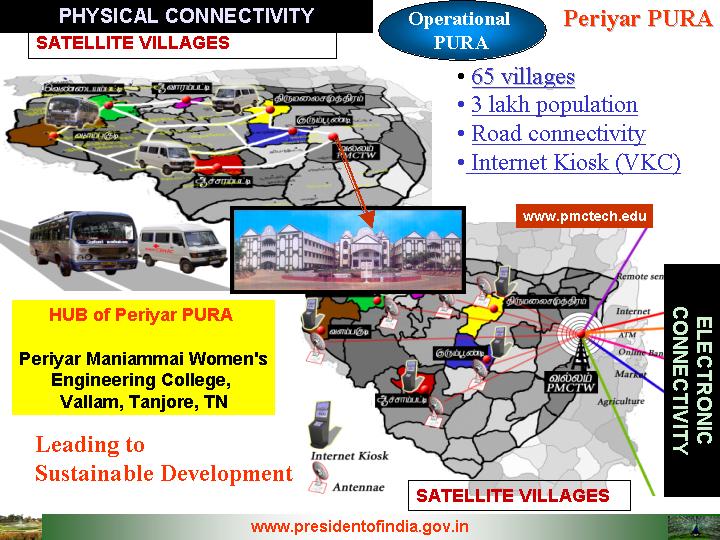
Two hundreds acres of waste land has been developed into a cultivable land with innovative water management schemes such as contour ponds and water sheds for storing and irrigating the fields. All the villagers are busy in cultivation, planting Jatropha, herbal and medicinal plants, power generation using bio-mass, food processing and above all running marketing centres. This model has emanated independent of any government initiative. The committed leadership has been provided by the Engineering institution. This gives me the confidence that PURA is a realizable proposition and this movement can be multiplied by thousands of entrepreneurs, educational administrators, small-scale industrialists and bankers with the support of the government agencies.
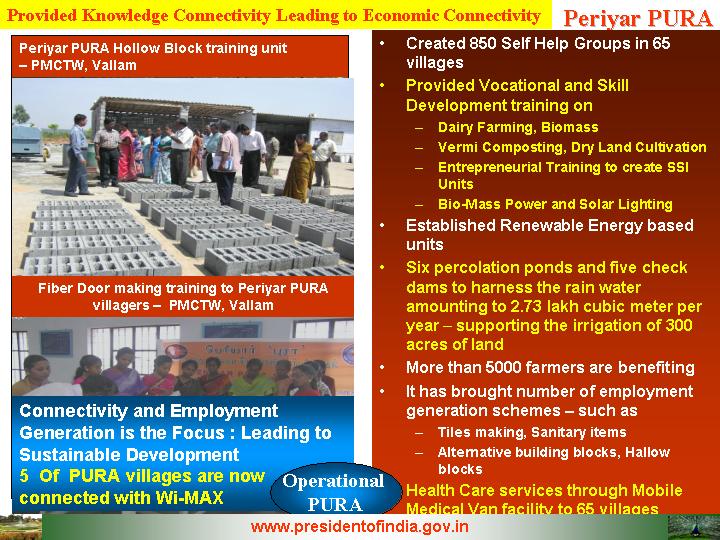

PURA: Loni Model (Maharashtra)
Recently, I visited a place called Loni in Maharashtra where a participative model of integrated rural development has come up among 44 villages with the population of 80 thousand. The architect of this model Shri Bala Saheb Vikhe Patil, MP of Maharashtra has a vision of improving the productivity of the rural people through improved quality of life with healthcare, education and employment. The concept is people centric development for social transformation. The thrust area of development has been on comprehensive Medicare particularly for women and children, need based health education and e-connectivity to the farmers. The complex has created 27 educational and vocational institutions consisting of schools, colleges, polytechnic and ITI including medical and engineering colleges. They have created sugar factory, biogas plants, chemical plants and power projects. They have large number of self-help groups for providing low interest loan for the weaker sections in the society.
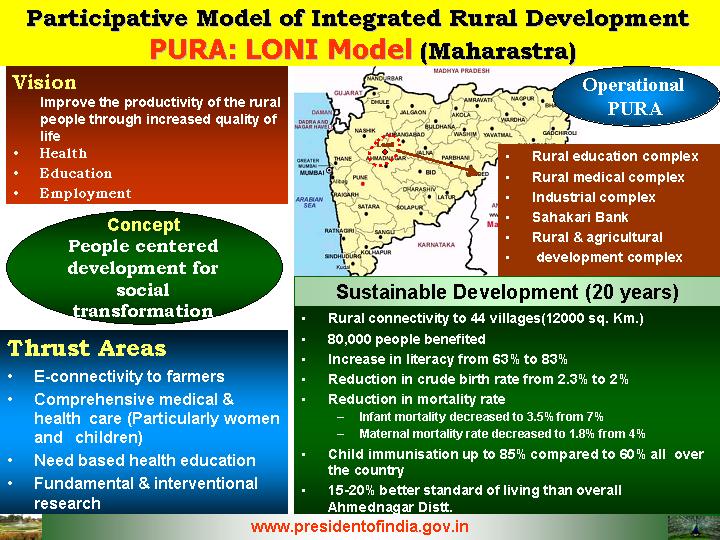
Due to the co-operative effort of the people, literacy in these villages has gone up from 63% to 83%, birth rate has come down, infant mortality rate has decreased to 35 per 1000 from 70 per 1000 and the standard of living of the people has gone up by over 20% compared to other villages in the neighbouring areas.
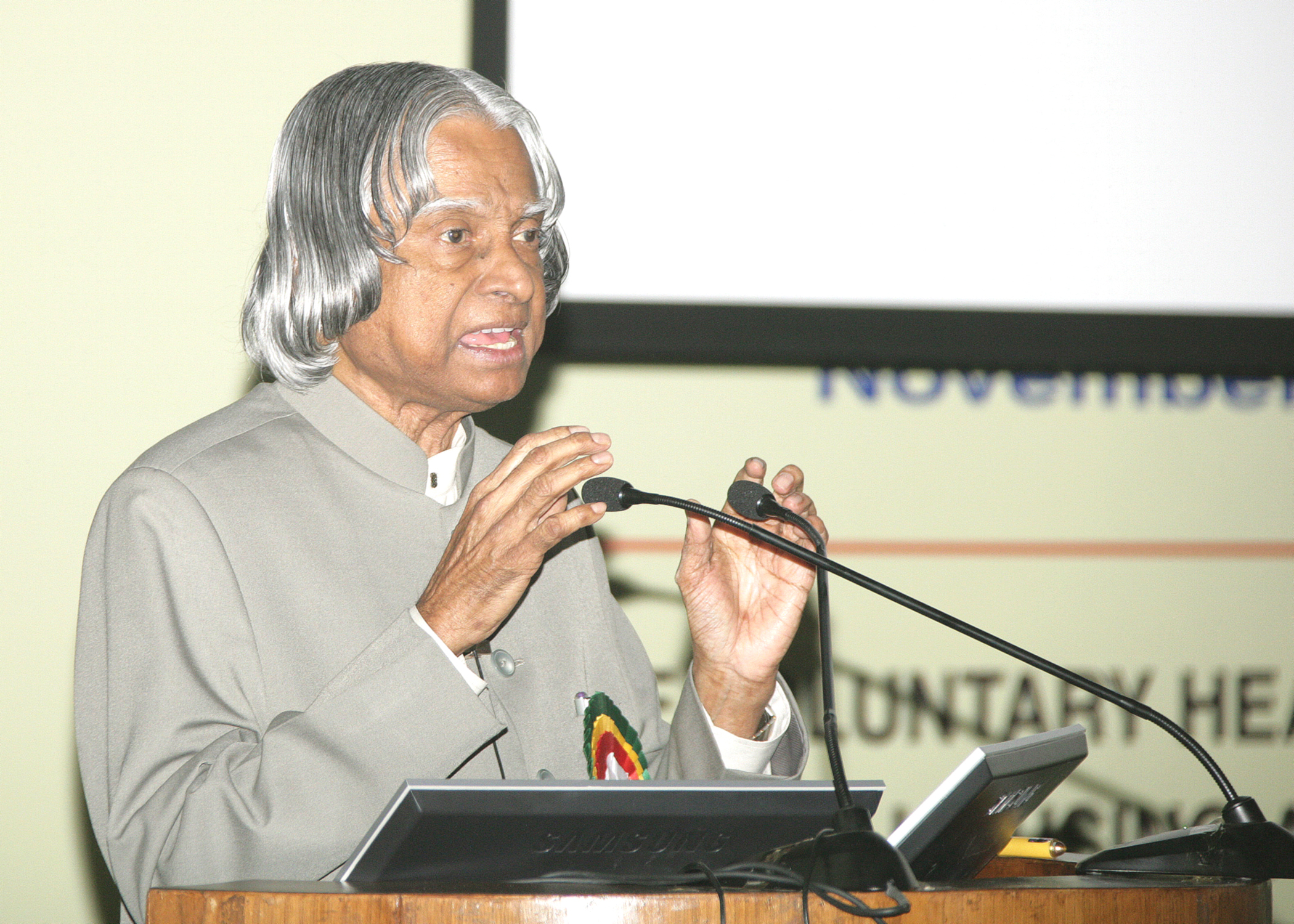

Chitrakoot Model
Recently I visited Chitrakoot in Madhya Pradesh, where I met Shri. Nana Deshmukhji (Age 90) and his team members belonging to Deendayal Research Institute (DRI). DRI is a unique institution developing and implementing a village development model, which is most suited for India.
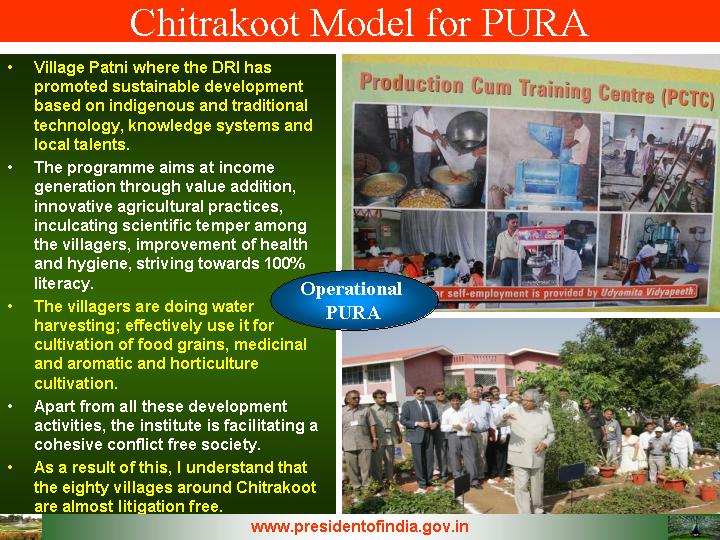
DRI understands that people's power is more potent, stable and enduring than political power. By becoming one with the oppressed and depressed, one gains the acumen of administration and governance. Social advancement and prosperity are possible only by injecting the spirit of self-reliance and excellence in the younger generation. Using this principle, DRI has plans to develop one hundred clusters of villages having approximately five villages each around Chitrakoot. They have already developed 80 villages in 16 clusters consisting of about 50,000 people.
I witnessed one of the villages called Patni where the institute has promoted sustainable development based on indigenous and traditional technology, knowledge systems and local talents. The research work by the institute through field studies facilitates the development of replicable and tangible model for achieving self-reliance in villages. The programme aims at income generation through value addition, innovative agricultural practices, inculcating scientific temper among the villagers, improvement of health and hygiene, striving towards 100% literacy. As a part of integrated rural development, the villagers are doing water harvesting; effectively use it for cultivation of food grains, medicinal and aromatic and horticulture cultivation. Apart from all these development activities, the institute is facilitating a cohesive conflict free society. As a result of this, I understand that the eighty villages around Chitrakoot are almost litigation free. The villagers have unanimously decided that no dispute will find its way to court. The differences will be sorted out amicably in the village itself. The reason given by Nana Deshmukhji is that if the people fight among each other they have no time for development. They can neither develop themselves nor the community. This message has been understood by the society and they have decided not to embark on any fighting. All these have been accomplished through DRIs "samaj-shil-pi dampati" (a graduate married couple) a new concept of counseling and intervention promoted by DRI. It was a great joy for me to take lunch with Patni village citizens. A new road connecting multiple villages in the Chitrakoot area is taking shape. In the same Chitrakoot environment there is another social organisation called Shri Sadguru Seva Sangh trust is carrying out number of social activities including the running of quality eye care center. In a rural environment, I find a revolution is taking place due to the committed leadership to remove the human pain.
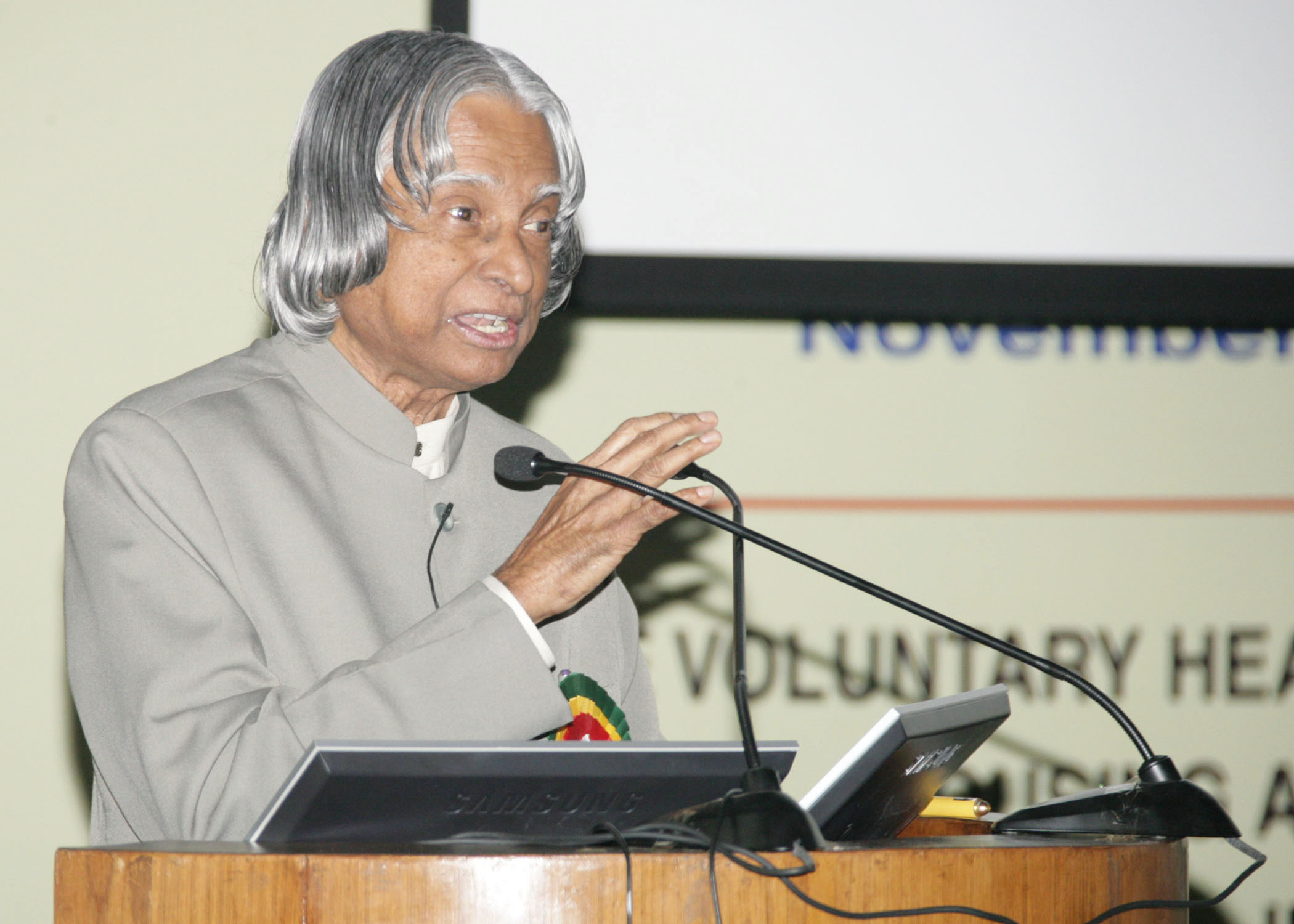
During my discussion with the Vice Chancellors of the hundred and fifty years old universities of Calcutta, Madras and Mumbai on 3rd October 2005, they have agreed to implement a PURA complex each at Diamond Harbor region of West Bengal by Faquirchand College, Chengalpattu region in Tamil Nadu by Vedachalam Government Arts College and Palghar region in Thane district, Maharashtra by Sonopant Dandekar Arts, Science and Commerce College. In addition, with the foundation of spiritual awakening gained from Akshardham, the volunteers of Akshardham have agreed to enrich the nation through commissioning of 1000 Akshardham PURAs (Providing Urban Facilities in Rural Areas) in different parts of the country within the next 5 years under the inspirational leadership of His Divine Holiness Pramukh Swamiji Maharaj.
Dear friends, the message so far I have given you is: there are many non-governmental institutions taking initiatives in developing PURAs. The Government institutions like Urban development ministries, IITs and the organizations who are present here today may participate in this effort.

PURA Components
Let me also highlight some independent initiatives that will become important components of PURA and can become employment generators in the rural areas.
Jatropha - Biofuel: Government has decided to permit mixing of 10% bio-fuel with diesel. Southern Railway is using 100% bio-fuel for running heavy vehicles like trucks, cranes, forklifts, jeeps and tractors. This has opened up new opportunities for employment and wealth generation. We have nearly 63 million hectares of wasteland available in the country, out of which 33 million hectares of wasteland have been allotted for tree plantation. Certain multi-purpose trees such as Jatropha can grow well in wasteland with very little input. Once grown the crop has a fifty years of life. Fruiting can take place in this plant in less than two years.
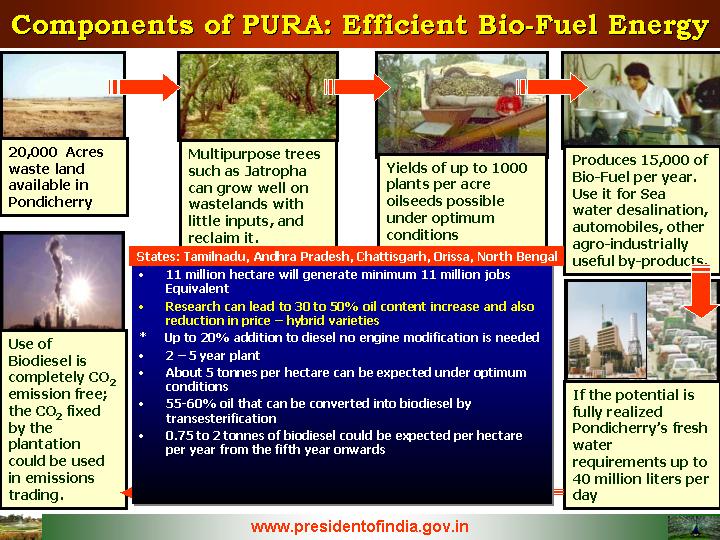
It yields oil seeds up to five tonnes per hectares per year and produces two tonnes of bio-diesel. Presently, the cost of bio-diesel through the plant is approximately Rs. 17 to Rs. 19 per litre, which can be substantially reduced through choice of right size of the plant and using high yield variety plantation. Bio-diesel plants grown in 11 million hectares of land can yield a revenue of approximately Rs. 20,000 crore a year and provide employment to over 12 million people both for plantation and running of the extraction plants. This is a sustainable development process leading to large scale employment of rural manpower. Also, it will reduce the foreign exchange outflow paid for importing crude oil, the cost of which is continuously rising in the international market. More over, use of Bio-fuel is carbon neutral. This oil can also be used for soap and candle industries. De-oiled cake is a raw material for composting. Also Jatropha plantation provides a good environment for honey production. We should absorb best of the technologies available worldwide and start commercial operation soon, instead of staying at pilot plant levels. I would request the industrial community assembled here to take the initiative, generate detailed project report in collaboration with technical agencies such as The Energy and Research Institute (TERI), TNAU and Agriculture university in Anand, on this project and promote entrepreneurs with financial support from the banks in rural areas who can undertake the plantation and commissioning of extraction plant leading to production of cost-effective bio-fuel. Can there be a better project than this for coherent development of our rural sector and sustainable business preposition for industry?
Textile industry: Textile industry is very important for the Indian economy. The basic raw material is cotton. India is the third largest producer of cotton in the world. However, compared to the world average of 700 kgs of seed cotton per acre, we produce only 350 kgs of seed cotton per acre. It is indeed a technological concern for the nation. Some of the industries have adopted a village in Punjab, which has brought out a cooperative movement of the farmers, scientists, trainers and the industry and launched for cultivating cotton in over 1200 acres. A training programme was launched for farmers starting with soil characterization, matching the cottonseed to soil, water and fertilizer management.
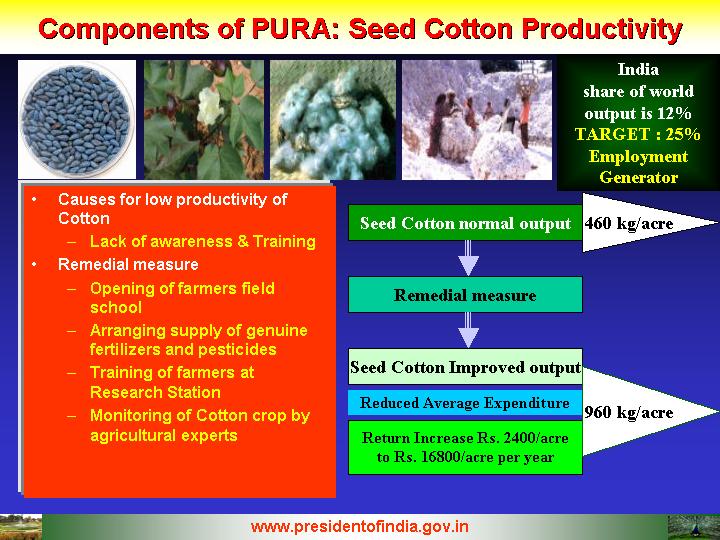
The project resulted in increasing the average seed cotton yield of the village from 450 KG per acre to 950 KG per acre. This led to the seven-fold increase in net return per acre, due to considerable reduction in input costs. It is worth noting that in this case the yield is above the world average. This model has already been replicated in twenty five villages in Punjab. The revenue increase due to higher production in these twenty-five villages is around Rs. 20 crore. Certainly many cotton-growing regions of the country can emulate this model. India can definitely produce 25% of the total world production of quality cotton compared to the existing 12% leading to revenue of over Rs. 25000 crores a year for the nation.
I would like to link cotton production to garment export business, which is a low investment and large volume employment generator. India is presently, exporting six billion dollars worth of garments, whereas with the WTO regime in place, we can increase the production and export of garments to 18 to 20 billion dollars within the next five years. This will enable, generation of employment in general and in rural areas in particular. By tripling the export of apparels, we can add more than 5 million direct jobs and 7 million indirect jobs in allied sector, primarily in the cultivation of cotton. Concerted effort is needed in Cotton research, technology generation, transfer of technology, modernization and upgrading of ginning and pressing factories and aggressive marketing strategy.
Converting the fly ash as Wealth Generator: As you are aware, the use of coal for power generation results in increased quantum of fly ash production, which has reached about 100 million tonnes per year. All out efforts are needed to utilize this fly ash not only from environmental considerations, but also to avoid land usage for fly ash dumping. Though there has been a steady progress in fly ash utilization from 1990, we have a long way to go to reach the target of 100% fly ash utilization. It is reported that the agricultural increase of grains is around 15%, green vegetables 35% and root vegetables 50%, when fly ash is mixed with the soil. Toxicity tests have proved that there is no toxic element due to fly ash. But it has higher nutrients due to increased availability of iron and calcium. The fly ash can become a wealth generator by making use of it for producing "green building" materials, road, agriculture etc. Presently, the fly ash utilization is in the range of 33 million tones per year and providing employment for over 50,000 personnel. For full utilization of the generating stock, will provide employment potential for three hundred thousand people and result in a business volume of over Rs. 4000 crore. Many PURAs clusters located near the Thermal power plants can make use of fly ash as a business proposition.
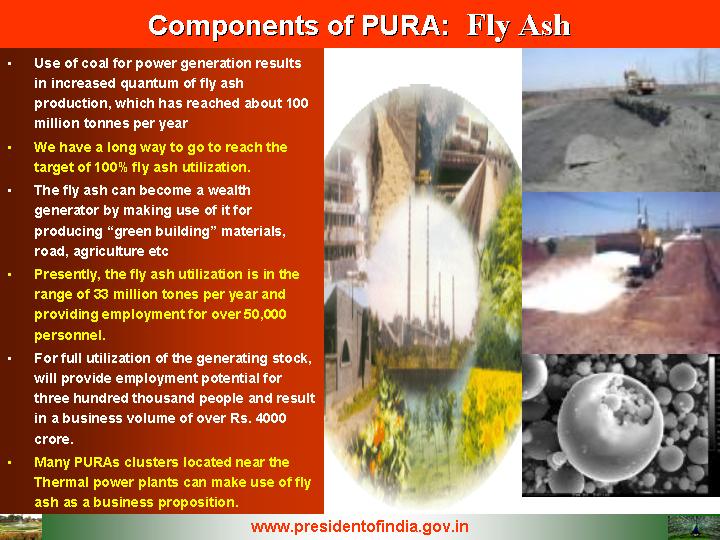
Village Knowledge Centers: With the kind of awareness and opportunities available in ICT, it will soon become a reality wherein every one of our villages will have computers and connectivity available. These would be the window to the world of knowledge for our villages and also to reap the benefits of our e-governance, tele-education, tele-medicine, e-commerce and e-judiciary initiatives. In spite of the all pervasive nature of the computers, they would still be far away from being a truly friendly access system for our villagers. We would need in such cases, a human intermediary who would act as the village information officer. He will be the extended eyes and ears of the villager to the world of knowledge. India has approximately 2.3 lakh Village Panchayats. I visualize establishment of village knowledge centers in these Panchayats to empower the villagers with the knowledge and to act as a nodal center for knowledge connectivity for the villagers. Village Knowledge Centers becomes the delivery mechanisms, which provides the knowledge connectivity from the domain service providers to villagers in the PURA Complexes. The knowledge center from which the villagers would access the information through the village information officer can also be used for collection, digital storage and dissemination of village specific information pertaining to any relevant information to the villagers. This will provide direct quality employment to over one million who will be instrumental in promoting higher level of wealth generation in PURA Complexes.
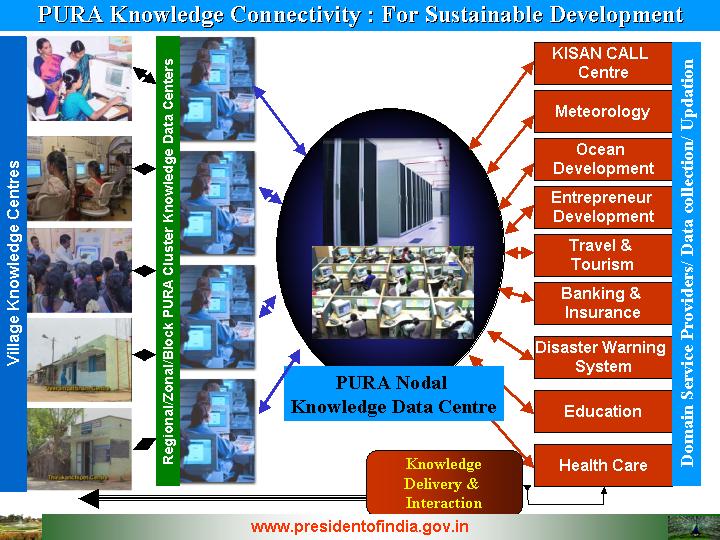

Conclusion
As you are aware we have been talking about PURA (Providing Urban Amenities in Rural Areas) as a growth driver of our economy for the last few years. Also number of conferences has been held by different institutions for conceptualization and implementation of PURA. Time has now come for consolidating all the thoughts, which have emerged in the development of PURA by different agencies. Also, we should realize that the Government has made a number of enabling provisions for growth of PURAs in different regions. Now is the time to work out and embark on the development of specific PURAs in every State. Certain State Governments like Chattisgarh have taken the lead and created viable PURA models. There is a need to consolidate all these experiences and launch at least 100 PURAs before the end of 2006 by the collaborative effort of societal organizations, educational institutions, bankers, industrialists, entrepreneurs and the Government. I would suggest that the participants of this workshop to formulate a plan of action for preparing detailed project reports of the hundred PURAs within the next six months and launch the PURA complexes in phases during the second half of 2006. I will be most willing to launch few PURAs planned by the members participating in this workshop. We must remember that workshop and conference phase is now over and we are in the implementation phase of the PURAs.
My best wishes to the participants of this seminar in the task of implementing PURA in the mission mode.
May God bless you.
<<Back
|
|